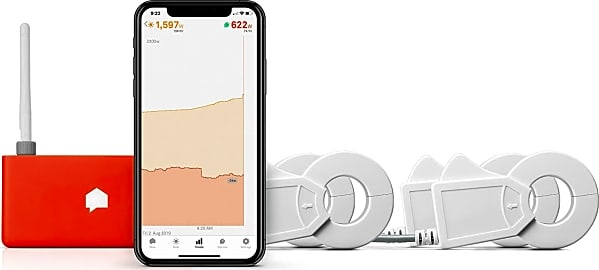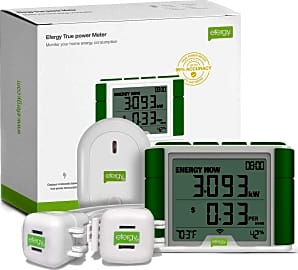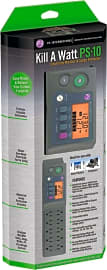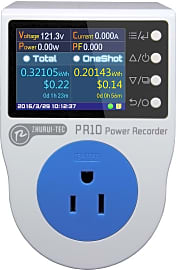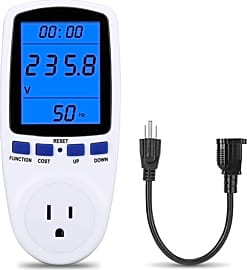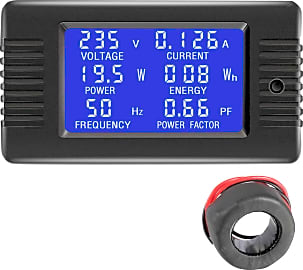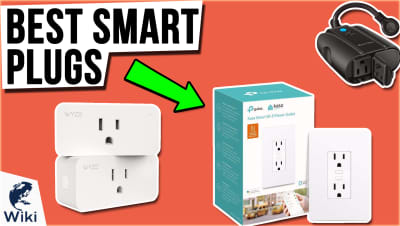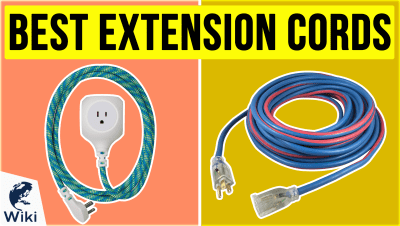The 10 Best Electricity Usage Monitors

This wiki has been updated 39 times since it was first published in July of 2015. If you know your watts from your amps and want to monitor and control the electricity consumption in your home or office, check out these usage meters. Some units will give you all the data you need for an energy audit of individual devices, while others measure your whole house or business, so you can keep your power bill as low as possible and reduce your carbon footprint. When users buy our independently chosen editorial picks, we may earn commissions to help fund the Wiki.
Editor's Notes
October 26, 2020:
Considering it’s only been 11 months since we last overhauled this list, it was a surprisingly busy round of updates, with nearly all of our previous selections replaced by superior offerings that are now available from their companies or elsewhere in this fast-moving category. Notably, the only two choices that made it through this time around are the CrocSee CRS-022A and Zhurui PR10-E US15A.
We removed the Blue Line Innovations Power Cost and Etekcity Voltson, due to availability issues, but made sure to replace the Voltson with the TopGreener Powerful Plug, as we thought it was important to make sure the list still included a plug-in smart outlet with monitoring abilities. The addition of the Powerful Plug also laid the groundwork for our elimination of the TP-Link Smart Plug, which cost almost the same as the Powerful Plug, but came as a single unit instead of a four pack.
We switched out the Sense 12000 for the Sense 12001, the latter essentially being an upgraded version of the former, with a pair of additional sensors intended to monitor your solar system. The Eyedro Wireless was also switched out — in this case for the Eyedro EYEFI-4, another upgraded model with solar-system compatibility, as well as the addition of Wi-Fi connectivity.
The Efergy E2 and Emporia Energy Vue were replaced by the Efergy True Power Meter and Emporia Vue Gen 2, with both new and improved models now monitoring true power instead of apparent power, which significantly increases their accuracy. The top-end Vue Gen 2 can also monitor 16 circuits, which is twice what the expanded version of its predecessor was capable of, making it a better choice for granular, whole-house monitoring applications.
The P3 International Kill A Watt P4460 – a plug-in model that was bit of a pain, as it blocked both outlets on a wall receptacle and multiple outlets on a power bar – was replaced in favor of the P3 International Kill A Watt P4330 — a 10-outlet surge protector with a built-in power monitor. For users happy to monitor just a single outlet, who don’t want to pay extra for the surge protector but still don’t want the P4460 occupying all their plug real estate, we added the Fayleeko Meter Plug, which comes with a short extension cord, providing an easy workaround for the problem.
Our final addition was the Spartan Power SP-PM120, which features few bells and whistles and can only monitor a single outlet, but boasts a more-than-adequate maximum current and power rating, and is priced very affordably.
If desire to drive down your utility costs is what drew you to this page, you may also be interested in some of our other rankings that are aligned with that goal. A few that come to mind include Best Outdoor Remote Control Outlets, Best Outlet Timers and Best Smart Home Water Monitors.
November 25, 2019:
This round of updates, we eliminated the Tacklife EM02 Classic and the Ensupra PM002 – due to availability issues, as well as the Excelvan HP1101 – after we noticed several troubling reports of the device causing electrical fires. In their place, we ranked the CrocSee CRS-022A – as we were a fan of its large LCD and its full range of readings, the Zhurui PR10-E US15A – for the slick appearance of its color display and the way it doubles as a wall timer, and the Emporia Energy Vue – because we wanted our rankings to include at least one option with three-phase functionality.
Here’s a few things to consider while exploring the category:
Installation: While none of the offerings we ranked should take particularly long to install, many require the installer to be in direct contact with live, unfused wires. If you’re considering purchasing any of these options, we strongly recommend you hire a reputable, licensed electrician, rather than putting yourself in harm’s way (and, your local bylaws will likely demand the same).
Some examples of models that require professional installation include the CrocSee CRS-022A, the Eyedro Wireless and the Emporia Energy Vue. Simpler, plug-and-play alternatives for those that are wary of working around electricity include the TP-Link Smart Plug, the P3 International Kill A Watt and the Etekcity Voltson.
Connectivity: While models that are less impressive in this respect – such as the Blue Line Innovations Power Cost and the P3 International Kill A Watt – can help reduce your up-front costs (not an absolute rule), the app connectivity that’s becoming increasingly common in this category is great for monitoring consumption while you’re away from home. You’ll also love the luxury of a larger screen when it comes time to comb through all the data you generate.
Functionality: Calculating kilowatt hours is a given for devices this category, but some options go a bit further, providing additional analytics for things like voltage, current and power factor. The Zhurui PR10-E US15A even doubles as a wall timer while it’s keeping track of usage.
How Electricity Usage Monitors Work
These monitors can help one identify which devices are using up the most power.
Electricity usage monitors are a smart purchase for anyone who is looking to cut back on power consumption, whether for environmental or monetary purposes. These monitors can help one identify which devices are using up the most power. They also display the consumption in the same measurements the electricity company does, making it easy to predict the cost of future bill.
If using a lot of power is simply not an option, many models allow the user to set a kilowatt limit. When a device is getting near that limit, the monitor sounds an alarm so people in the house know to turn it off. Electricity usage monitors can show useful information like the total power consumed by a device per day, keeping track in real time, and resetting every 24 hours.
Many monitors can connect to several devices around your home, letting you navigate the control screen, checking on each one individually. People who travel a lot appreciate units that can be used remotely. Bluetooth compatible monitors not only allow the user to check on their in-home power use when they’re away, but also to turn on devices remotely.
Many monitors plug directly into a wall socket, so a person can easily use these in their home or office. Some let the user plug a device directly into them, to get an immediate, real-time read on that item’s power consumption. Advanced models have cloud computing technology that lets a person check on their home’s power consumption from any Internet-connected device, and save data for the user so they can track their habits.
Top Energy Wasting Habits
In addition to using an electricity monitor, there are a number of other habits one can adopt to conserve energy in their home. There are several things that can be done differently around the kitchen to save power, like deciding what to eat before opening the refrigerator. People spend an average of 10.4 hours per year staring into their open refrigerator, wasting the electricity used to turn the light on, and to cool it back down when shut. And the refrigerator isn’t even the most expensive appliance in the home.
They simply cool down the object they are facing and if that’s a wall, that’s a waste of energy.
Using the oven is uncomfortable enough during the summer months, but it can also be costly. Air conditioner units work overtime when an oven is turned on, to compensate for the added heat in the room, so baking on hot days is irresponsible. Many often leave the oven preheating for longer than necessary while they work on other food preparation tasks.
Fans should only be on in rooms occupied by humans. Fans do not cool down an empty room. They simply cool down the object they are facing and if that’s a wall, that’s a waste of energy. Failing to set a thermostat is financially and electrically neglectful. Most people who turn on their air conditioner with the idea of turning it off when the home feels cool enough often forget to shut it off. A thermostat can prevent hours of wasted air conditioning power.
In the entertainment room, items like DVD players, speakers and cable boxes do not need to be left on all day. Most people only use these items for a few hours at night, and yet they leave them plugged in all day while they’re at work, and all night while they’re asleep. Many of these devices drain small amounts of power even when not in operation. It's known as a vampire drain and it happens in many common household electronics. Falling asleep in front of the television can also be a major electricity-waster, especially if it’s a person’s nightly habit.
The Most Energy Efficient Cities
Some cities make energy efficiency a top priority, and doing so can improve their economy and their environment. Considering that cities consume 75 percent of the world’s natural resources, it’s imperative that officials consider ways to cut back on power consumption.
Reykjavik, Iceland gets all of its heat, electricity, and hot water from renewable hydropower and geothermal plants. In the mid-2000s, the city replaced most of its public transportation with hydrogen-fueled buses, which only emit pure water into the atmosphere.
These lights adjust their electrical output depending on the weather and traffic conditions.
Portland, Oregon replaced its old streetlights with LED models that consume less energy. The city has always been environmentally conscious: in the 1970s, it removed a six-lane highway to make room for a waterfront park. Portland’s power-conscious citizens use bicycles as one of their main forms of transportation as well.
Vancouver, Canada is another city that boasts clean air. It has the lowest per capita carbon emissions of any major city in North America and receives 90 percent of its energy from hydroelectric power. Vancouver gets its other 10 percent of energy from renewable sources like wind, solar, and wave power.
Oslo, Norway, with its distinct four season weather, uses intelligent lights on their streets. These lights adjust their electrical output depending on the weather and traffic conditions. The city also powers most of its heating systems with biomethane, a renewable energy source retrieved from their waste product. Scandinavia is home to another highly energy efficient city, Copenhagen, Denmark. Over one-third of the city’s residents ride bicycles every day, and the city grows several rooftop gardens, which help insulate buildings.


